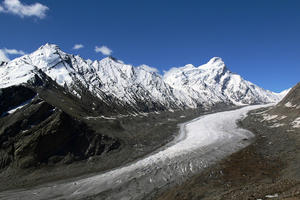Water shortageHimalayan glaciers to shrink even if temperatures hold steady, risking South Asia water supply
Come rain or shine, or even snow, some glaciers of the Himalayas will continue shrinking for many years to come; the most conservative findings of a new research on Bhutan, a region in the bull’s-eye of the monsoonal Himalayas, indicate that even if climate remained steady, almost 10 percent of Bhutan’s glaciers would vanish within the next few decades; what is more, the amount of melt water coming off these glaciers could drop by 30 percent

Drang-Drung glacier, source of India's Zanskar River // Source: commons.wikimedia.org
Come rain or shine, or even snow, some glaciers of the Himalayas will continue shrinking for many years to come.
The forecast by Brigham Young University geology professor Summer Rupper comes after her research on Bhutan, a region in the bull’s-eye of the monsoonal Himalayas. Published in Geophysical Research Letters, Rupper’s most conservative findings indicate that even if climate remained steady, almost 10 percent of Bhutan’s glaciers would vanish within the next few decades. What is more, the amount of melt water coming off these glaciers could drop by 30 percent.
A Brigham Young University release quotes Rupper to say that increasing temperatures are just one culprit behind glacier retreat. A number of climate factors such as wind, humidity, precipitation and evaporation can affect how glaciers behave. With some Bhutanese glaciers as long as thirteen miles, an imbalance in any of these areas can take them decades to completely respond.
“These particular glaciers have seen so much warming in the past few decades that they’re currently playing lots of catch up,” Rupper explains.
In fact, snowfall rates in Bhutan would need to almost double to avoid glacier retreat, but it is not a likely scenario because warmer temperatures lead to rainfall instead of snow. If glaciers continue to lose more water than they gain, the combination of more rain and more glacial melt will increase the probability of flooding — which can be devastating to neighboring villages.
“Much of the world’s population is just downstream of the Himalayas,” Rupper points out. “A lot of culture and history could be lost, not just for Bhutan but for neighboring nations facing the same risks.”
To illustrate the likelihood of such an outcome, Rupper took her research one moderate step further. Her results show if temperatures were to rise just 1 degree Celsius, the Bhutanese glaciers would shrink by 25 percent and the annual melt water would drop by as much as 65 percent.
With climate continuing to warm, such a prediction is not altogether unlikely, especially given the years it can take for glaciers to react to change.
To make more precise predictions for Bhutan, Rupper and BYU graduate students Landon Burgener and Josh Maurer joined researchers from Columbia University, the Lamont-Doherty Earth Observatory, NASA and Bhutan’s Department of Hydro-Meteorological Services. Together, they trekked through rainforests and barren cliffs to reach some of the world’s most remote blocks of ice. There they placed a weather station and glacier monitoring equipment that can be used to gather real-time data in the months and years to follow.
“It took seven days just to get to the target glacier,” Rupper recounts, having returned in October. “For our pack animals, horsemen and guides, that terrain and elevation are a way of life, but I’ll admit the westerners in the group were a bit slower-moving.”
Rupper’s forecasts and fieldwork are among the first to look at glaciers in Bhutan, and the government hopes to use her research to make long-term decisions about the nation’s water resources and flooding hazards.
“They could potentially have a better idea of where best to fortify homes or build new power plants,” Rupper says. “Hopefully, good science can lead to good engineering solutions for the changes we’re likely to witness in the coming decades.”
— Read more in Summer Rupper et al., “Sensitivity and response of Bhutanese glaciers to atmospheric warming,” Geophysical Research Letters 39 (9 )ct0ber 2012) (doi:10.1029/2012GL053010)
